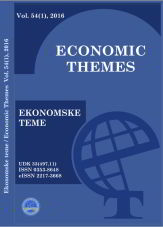Economic Themes (2016) 54 (1) 5, 83-102
Dejana Gajinov
Abstract: Asia-Pacific (AP) region is the world’s most important region today from the viewpoint of long-term economic growth. It is also the extremely important cite of rivalries or partnerships - or both - between China and the United States. The strong expansion of trade, investment and other economic ties within the AP region has stimulated the process of economic integration. The network of bilateral and regional free trade agreements has increased dramatically in recent years, linking virtually all major trading countries in the region, with one exception: either the US or China have not become members of the free trade arrangements involving the other country. The paper examines the scope, principles and characteristics of economic relations and cooperation in the AP region. The issue of whether Asian efforts for regional integration have been compatible with an open multilateral trading system at the global level is also addressed. The paper also assesses changes in the dynamics of regional integration and its future prospects. In this sense, in the Asia Pacific there are now two tracks which lead to the formation of a Free Trade Area of the Asia-Pacific (FTAAP): Asian, based on the Association of Southeast Asian Nations (ASEAN) and the Regional Comprehensive Economic Partnership (RCEP) and trans-pacific, based on Trans-Pacific Partnership (TPP).
Keywords: economic integration; Asia-Pacific region; open regionalism; ASEAN; EAC; RCEP; APEC; TPP; FTAAP
TRANS - PACIFIC ECONOMIC INTEGRATION PROCESSES
Dejana Gajinov
Abstract: Asia-Pacific (AP) region is the world’s most important region today from the viewpoint of long-term economic growth. It is also the extremely important cite of rivalries or partnerships - or both - between China and the United States. The strong expansion of trade, investment and other economic ties within the AP region has stimulated the process of economic integration. The network of bilateral and regional free trade agreements has increased dramatically in recent years, linking virtually all major trading countries in the region, with one exception: either the US or China have not become members of the free trade arrangements involving the other country. The paper examines the scope, principles and characteristics of economic relations and cooperation in the AP region. The issue of whether Asian efforts for regional integration have been compatible with an open multilateral trading system at the global level is also addressed. The paper also assesses changes in the dynamics of regional integration and its future prospects. In this sense, in the Asia Pacific there are now two tracks which lead to the formation of a Free Trade Area of the Asia-Pacific (FTAAP): Asian, based on the Association of Southeast Asian Nations (ASEAN) and the Regional Comprehensive Economic Partnership (RCEP) and trans-pacific, based on Trans-Pacific Partnership (TPP).
Keywords: economic integration; Asia-Pacific region; open regionalism; ASEAN; EAC; RCEP; APEC; TPP; FTAAP

